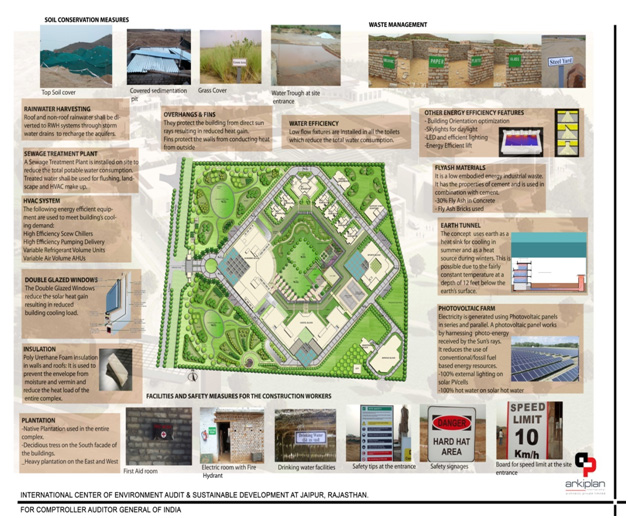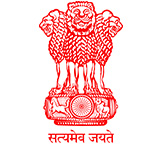International Centre for Environmental Audit & Sustainable Development (iCED)
Ms.Rebecca Mathai, IA&AS
The International Centre for Environmental Audit & Sustainable Development (iCED) at Jaipur was inaugurated by the Hon’ble Vice President of India in May 2013. Spread over 16 acres, its facilities include two Training halls, 2 smaller Meeting Rooms, an Auditorium, a Demonstration Laboratory and a Library. The hostel can accommodate 60 trainees at any given point of time. The building was conceived as a green building and aims to achieve Green Rating for Integrated Habitat Assessment (GRIHA) ratings. iCED will then be the first 5 star green rated government building in India.
The Hindu reported on iCED in May 16, 2013
Green building in Pink City
“Use of local materials like red sandstone and marble from local quarries and fly ash bricks has helped to cut down on pollution and transportation costs during construction. Energy efficiency features like orientation optimization, overhang sizing, skylights, insulation on walls/roofs, LED and efficient lighting and 100 per cent external lighting on solar PV cells are additional “green” attributes. While increased natural lighting has been used to lower consumption of power, use of control devices is used to further lower the lighting levels automatically during daytime. Solar Panels have been used for outdoor lighting and heating water, in addition to CFC-free materials. The green building also has rain harvesting system and a self-contained solid waste management system, i.e. waste disposal garbage collection and segregation system, use of composting techniques for organic waste like organic kitchen waste, garden waste, etc. Geothermal cooling has been used by introducing an alternate cooling system which can recycle cool air from below the earth’s surface (below 4 meters) into the building complexes. This coupled with solar chimneys would reduce the dependence on air conditioners". |
iCED as a green building: pictorial representation of green features of iCED

Its “greenness” has evinced a lot of interest in the building. But questions we are often asked is this: “Why has the CAG of India invested in such an infrastructure?” and that “the CAG of India has conducted environment audits in the past. So what will be different with iCED around?”
The threats to environment in India and globally are real. Can we meet today’s needs without diminishing the capacity of future generations to meet their own? This is the challenge of “sustainable development”. It embodies a concern for taking a broad view of what human welfare entails, and for balancing the goals of economic efficiency, social development and environmental protection. Globally, the majority of the environmental impacts on the planet have been caused by the rich minority, the 20 per cent that jumped onto the industrial bandwagon in the mid-18th century.
And we are a young planet. A third of the people on Earth are kids: kids who are growing in a completely different way than their parents did, most of them growing up in the under-developed world legitimately aspiring for a life which
Sample these…
- India has the world’s 3rd largest ecological footprint, after USA and China. Indians are almost using twice the sustainable level of natural resources that the country can provide;
- India has the highest volume of groundwater overuse in the world. Water tables have dropped, in some places alarmingly;
- Of the total forest land diversion that has taken place since 1980-81, about 55% has been after 2001.
Source: Kalpavriksh
- Almost 70 % of surface water and large % of groundwater in India is contaminated by biological, toxic, organic and inorganic pollutants;
- According to the WHO, 13 of the 20 most polluted cities across the G-20 economies, are in India
|
is more prosperous, more enjoyable, but may not be sustainable.
This is the reality in India as well(see box). We as public auditors can hardly ignore this issue. It is widely accepted that the precautionary principle is a better policy option than totally ignoring the environment imperative. Indiscriminate exploitation of resources can be halted by and even reversed by active government action in this area and we, as public auditors can contribute to this discussion by our evidenced reporting along with well researched recommendations. Environment audits have played and will play an important role in highlighting the failure of the executive in effective conservation of the environment. Creation of iCED by the CAG of India is an expression of waking to this reality and its role in this reality; being ready for the challenge; and emerge as a leader in the INTOSAI community in the field of environment audit and audit of sustainable development. Since these audits are poised for an increase, there is a need to acquaint, familiarise and train ourselves in audit of these issues.
It is also true that the CAG of India has been conducting environment audits over a decade. In fact, we have done more than 100 audits with an overlay of environment issues: in audit of environment related programmes (Ganga Action Plan), audit of oversight bodies like National Biodiversity Authority and more recently, audits with an overarching canvas like Water Pollution in India. So we are not new to these audits. But they have been largely audit of government programmes on environment. In order to participate in the environment debate in the country, we need to look at environmental issues holistically: the thread that cross-cuts various departments and agencies. We don’t have a regular churn-out of environment audits; it is sporadic and the outcome of individual initiatives of offices. Environment risks are not integrated into the institutionalised risk assessment framework for selection of topics.
The recent report on “Environment Management in Indian Railways (IR)” serves as a case study. That the Railways could be a significant contributor to environmental threats in the country is a new perspective for a common man. CAG of India chose this topic with a certain amount of prescience, the product of individual initiatives and not informed by an institutionalised IA&AD-wide environmental risk assessment to identify auditable issues. In its absence, we could well have missed this topic.
The Audit Report is prefaced with the following:
“Indian Railways (IR)" handles 7651 million passengers and carries 922 million metric tonnes of goods traffic per annum. It is the second largest carrier of passengers in the world and carries about 35 per cent of the total freight in the country. Indian Railways (IR) is the single largest carrier of freight and passengers in the country. It is a bulk carrier of several pollution intensive commodities like coal, iron ore, cement, fertilizers, petroleum etc. Being a major consumer of water and energy, policies adopted by the IR have a substantial impact on our environment and on the conservation of both water and energy in the country. The approach of Indian Railways (IR) towards protection of the environment, therefore, assumes great importance for tackling environment challenges to the country.
Recognising its importance, CAG of India has decided to do a 3-phase audit of “Environment Management in India”: The present report presents the results of the first phase of this exercise. In the next phase will cover workshops, sheds and production units of Railways and in the final phase, environment management in offices, colonies, hospitals will be taken up. |
Environment audits present different sets of challenges. Once again, the Railway Report is a good case study. For instance: Handling and transportation of commodities like coal, iron ore, cement, fertiliser etc. at sidings/goods sheds in open wagons, causes air pollution. But comprehensive guidelines specific to operation of sidings for handling and transport of pollution intensive commodities have not been issued either by the Railway Board, the Central Pollution Control Board or the State Pollution Control Boards. Thus framing audit criteria required a fair amount of imagination and search.
Data on environment is also difficult to come by. For instance: there was no comprehensive data on the quantum of waste or extent of pollution in railway premises. The auditor had to commission an independent assessment of pollution of air, water and noise at station premises/sidings/sheds through the Central Pollution Control Board in at 14 major stations spread over 12 zones. The results of a previous study by of RITES on waste generation in select stations of Delhi, served as an indicator of the quantum of waste generated in railway stations.
These challenges underline the need for a training & research centre that can assist the audit offices which have scarce resources and a wide audit universe, to conduct relevant audits in the field of environment & sustainable development. A risk assessment framework prepared by iCED that can be drilled down from the National level – States- Departments- programmes, will provide the audit offices with a template to choose their audit topics. If provided with real-time assistance to audit parties as they embark on the audits, iCED will enrich the quality of the audits.
As such, activities of iCED encompass a broader canvass than merely training. Training or dissemination of training materials alone does not help in meeting the objectives of capacity building. An important component is handholding while conducting the audits: when iCED can assist the audit teams in selection of criteria, identifying audit objectives; assist in identifying sources of data; participate while establishing the criteria-condition-cause-conclusion-recommendation trail to ensure that the reports are comprehensive and provide the big picture. This does not envisage a role for iCED in drafting of the audit report or its clearance, but providing assistance when sought by audit offices.
Vision
We aim to be a global Centre of Excellence for improving accountability and governance in the area of environment and sustainable development.
Mission
We will develop high quality products in training and research to enrich environment audit through an inter-disciplinary approach enabled by valuable partnerships
Values
- Professional excellence
- Objectivity
- Concern for environment
- Learning organisation
- Collaborative approach
Strategic objectives
- Be a knowledge centre that fosters learning and builds capacity for audit of issues relating to environment and sustainable development
- Promote mainstreaming environment concerns among government agencies and public auditors
- Undertake research that informs the processes in audit as well as governance structures related to these issues
- Be an information hub on environment, sustainable development and audit related issues for wide dissemination and use
- Build partnerships with SAIs and other organisations working in this area for knowledge and experience sharing
- Develop a modern institution which is efficient, effective and adaptable, adopting best management practices
|
An integrated approach from the beginning1 would help the CAG of India to gain a comprehensive perspective across the audit universe. Which means, accepting first of all that environment audit is not different from the audits that we are familiar with. Such integration of environment audit into the basic audit processes of the functional wing, will ensure that the expertise and knowledge is captured institutionally, spread across a wider spectrum of staff and not the preserve of a few.
iCED through its institutional partnerships can bring together expertise from different fields to facilitate an inter-disciplinary approach in our audit work. For instance, an audit on management of coal reserves could involve experts from the industry, learning institutions like ISM, Dhanbad; environmentalists, NGOs etc., at the time of audit planning and at the stage of finalising audit findings/recommendations2.
Effective training needs a firm link with research in iCED and a steady flow of audits that pilot the guidance notes issued by iCED, test the assumptions that underpin such research, add depth to our understanding especially at the grass roots level (for eg: most environment laws are implemented by local bodies) and can form case studies for the training. Creation of iCED manifests an intention of CAG of India to play a leadership role internationally which cannot be achieved without such audits forming an integral part of our audit products and to repeat, without ensuring a steady flow of audit work.
iCED has been recognised as the Global Training Facility (GTF) of the INTOSAI on Environment Audit. The first GTF training will be held in November 2013. What makes this training unique? The programme has six modules, each prepared by an expert in the area from different SAIs and the training will be imparted at Jaipur by these experts. SAIs from USA, Estonia, Brazil, Norway, Finland and of course, India will prepare and train at this GTF programme that is open to SAIs all over the world. iCED can share and learn among the best in the field, soak the learning experience and suffuse it in its national training programmes as well as share the best sessions with all, on its website.
This is a challenge but it also opens exciting opportunities to establish CAG of India as a leader in the area of environment audit & sustainable development. The first steps are important; the foundation must be strong for us to be able to build ourselves in this area.
1The risk assessment can help to segregate the entities into distinct categories: (a) those which have a significant risk (with environment audit perspective) and can be taken up for a Performance Audit (PA) or (b) those for which laid down checks at the local audit will suffice or (c) those for which an integrated audit will be warranted.
2Peer Review Report had recommended that SAI India should seek comments from experts to inform our audit work.
|







